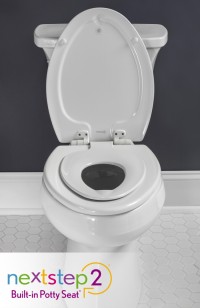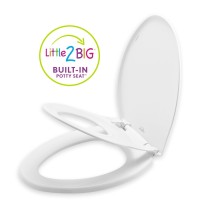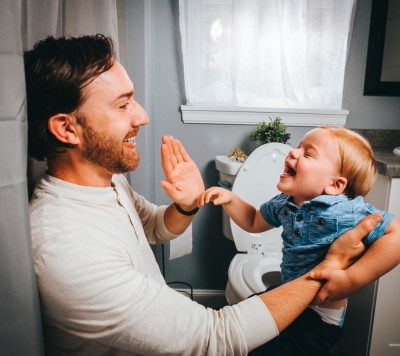Solutions to Four Common Potty Training Problems
 It’s easy to visit popular parenting forums and read potty training success stories. But when your child’s potty training was going well and he suddenly regresses, or out of the blue she flat-out refuses to use the potty, what to do? It’s easy to start thinking that you’ve “failed” at potty training, or your child will “never” get there.
It’s easy to visit popular parenting forums and read potty training success stories. But when your child’s potty training was going well and he suddenly regresses, or out of the blue she flat-out refuses to use the potty, what to do? It’s easy to start thinking that you’ve “failed” at potty training, or your child will “never” get there.
Relax. Honestly. Potty training setbacks and detours are normal. If you view them as frustrations, your child will pick up on that and likely respond in ways that generate a power struggle. Instead, take time to figure out what’s going on so you can get the potty training process back on track.
Following are four common potty training issues and solutions for navigating them.
Your Toddler Is Anxious/Uncertain
It’s normal for some children to feel uncertain about potty training. After all, since birth she’s been used to the sensations of a wet/dirty diaper and now she’s being expected to do something completely new and different with her body wastes. Children crave routine, and starting potty training may cause anxiety.
 If your child is uncertain about the toilet, have a gentle talk. If he feels intimidated by its size; get a stepstool to help him get on the toilet. Having his feet raised also makes it easier for him to control his voiding muscles, too. Using a built-in potty seat, like the NextStep2®, can help. Because the potty seat is sized for him and will not shift, he gains confidence using the toilet!
If your child is uncertain about the toilet, have a gentle talk. If he feels intimidated by its size; get a stepstool to help him get on the toilet. Having his feet raised also makes it easier for him to control his voiding muscles, too. Using a built-in potty seat, like the NextStep2®, can help. Because the potty seat is sized for him and will not shift, he gains confidence using the toilet!
Children can feel anxious if they're constipated. If this happens, make sure he is drinking enough liquids and consuming fiber-rich foods. Constipation can cause straining and can be painful and frustrating for your child.
If your child is still anxious, she may just not be ready. Or she may feel outside pressure – for example, if new sibling is on the way or if day care starts in a few weeks, it’s tempting to push potty training so its “taken care of.” But that rarely creates success. To address this, learn the signals that your child is ready for potty training. If she isn’t, hit the pause button and use this time to let her investigate the potty seat and ask questions. Then begin again when she’s truly ready, no matter what outside pressures exist.
Your Toddler Asks for Diapers
This is a common potty training problem. So instead of letting this become a power struggle, determine what’s behind his request. Is he afraid that potty training means he’s no longer a baby? Meet this with reassurance and compassion. Is she is embarrassed by accidents? Let her know that accidents are normal and nothing to worry about. If you know he’s simply being headstrong and stubborn, resist the urge to demand your way – this only creates unnecessary power struggles that further derail potty training. Instead, remind him that he’s a big boy who knows how to do important things – like set the table or pick up his toys – and he probably doesn’t really need a diaper.
Your Toddler Balks at Shifting From a Potty Chair to the Toilet
You’re in the store and your toddler cries, “I have to go potty!” You rush to the bathroom and pull open the stall door, but one look and she refuses to use that toilet. After all, she’s used to her little potty chair at home and this one is…different.
 It’s hard to do this in the moment, but next time you’re shopping and there isn’t a “potty emergency” on the horizon, take your child into the bathroom and point out the similarities between this setup and the one at home: The toilets are both white. The toilet paper is nearby on the wall. They both flush with a handle. Although you can see the differences, your toddler relies on your reassurance to make new situations understandable.
It’s hard to do this in the moment, but next time you’re shopping and there isn’t a “potty emergency” on the horizon, take your child into the bathroom and point out the similarities between this setup and the one at home: The toilets are both white. The toilet paper is nearby on the wall. They both flush with a handle. Although you can see the differences, your toddler relies on your reassurance to make new situations understandable.
To help the transition, get her a Little2Big™ potty seat. It has benefits for both of you! First, it installs on the toilet bowl, allowing your child to become familiar with using a “big toilet” no matter where she is. Second, because the child ring is sized for her, she gains a sense of control over the process, which equals success for all. And last, Little2Big lets you flush the mess away, eliminating one unpleasant task from your day!
Your Toddler Wants You to Come in the Bathroom
Using the bathroom independently is a skill set your child will need when going to day care, play dates, and other social situations. The sooner you set him up for success, the easier it will be to encourage this behavior. Suggestions include:
- Keep the path to the toilet clear of clutter. Children generally wait until the last minute to run to the bathroom, and a clear path makes this easier.
- Keep supplies easy for your child to reach. Toilet paper, soap and towels should be at his level if possible, and always in the same places so he knows what to expect.
- Ahead of time, teach her how to pull down her pants and pull them back up again. Make it fun – set out different pants and play music while your child practices putting on and taking off her pants several times.
- Encourage independence outside the bathroom. “Do you want an apple or an orange?” “Should we read two or three books before bedtime?” Giving him control over decisions creates confidence; remind him of these good choices when he asks you to come in the bathroom.
When your child has the tools to act independently, he’s less likely to ask for your help using the toilet. If he does, gently remind him that he already knows what to do and you’ll be waiting just outside the door so you can celebrate his achievement when he’s finished!
Read our other helpful potty training articles!
